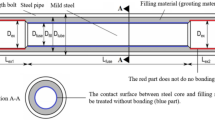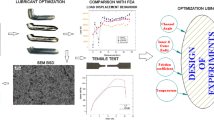Abstract
The tube hydroforging process (THFG) is an advanced technology for manufacturing tubular components with complex cross-sections. The positive-curvature arc is one of the most fundamental and difficult-to-form features of complex cross-sections. However, its wrinkling mechanism in the THFG process cannot be explained by the existing theory. This restricts the application of the technology. First, because of the bending deformation caused by the excessive circumferential force, compression instability occurs at the positive-curvature arc part. This results in wrinkling similar to that in the conventional linear part. In addition, owing to the existence of the positive-curvature arc, the circumferential force produces a component force along the vertical direction that causes rigid displacement of the materials. This yields another new instability model: motion instability. The corresponding critical pressures for the two instability models were determined by adopting static method and energy methods respectively. Theoretically, motion instability is dominant in the early stages of compression, whereas compression instability is dominant in the subsequent stages. However, considering actual production, the correlations between the critical pressures of the different parts were compared. The wrinkling of the linear part inhibits the occurrence of compression instability in the positive-curvature arc. Thus, wrinkling of the arc can be caused only by motion instability. Therefore, the critical pressure for motion instability is defined as the critical pressure required for the positive-curvature arc. In addition, a forming window that considers the critical pressure of each part was established successfully.

























Similar content being viewed by others
References
Abdelkefi, A., Guermazi, N., Boudeau, N., Malécot, P., Haddar, N.: Effect of the lubrication between the tube and the die on the corner filling when hydroforming of different cross-sectional shapes. Int. J. Adv. Manuf. Technol. 87, 1169–1181 (2016)
Cao, J.: Prediction of plastic wrinkling using the energy method. J. Appl. Mech. 66, 646 (1999)
Cao, J., Boyce, M.C.: Wrinkling behavior of rectangular plates under lateral constraint. Int. J. Solids Struct. 34, 153–176 (1997)
Cao, J., Wang, X.: An analytical model for plate wrinkling under tri-axial loading and its application. Int. J. Mech. Sci. 42, 617–633 (2000)
Chen, Y.Z., Liu, W., Xu, Y.C., Yuan, S.J.: Analysis and experiment on wrinkling suppression for hydroforming of curved surface shell. Int. J. Mech. Sci. 104, 112–125 (2015)
Chen, G., Yao, S.J., Chen, B.G., Chu, G.N.: Research on tube hydro-forging process of trapezoid-sectional parts. Int. J. Adv. Manuf. Technol. 107, 1901–1908 (2020)
Chu, G.N., Chen, G., Lin, Y.L., Yuan, S.J.: Tube hydro-forging - a method to manufacture hollow component withvaried cross-section perimeters. J. Mater. Process. Technol. 265, 150–157 (2019)
Chu, G.N., Chen, G., Wang, G.D., Fan, Z.G., Li, H.: Analysis of warping failure in tube hydro-forging. Int. J. Mech. Sci. 165, 105216 (2020)
Donnell, L.H., Akron, O.: A new theory for the buckling of thin cylinders under axial compression and bending. Trans. ASME 56, 795–806 (1934)
Feng, H., Han, C.: Deformation behavior in the hydroforming of overlapping tubular blanks. Int. J. Mach. Tools Manuf 158, 03624 (2020)
Gouveia, B.P.P., Alves, M.L., Rosa, P.A.R., Martins, P.A.F.: Compression beading and nosing of thin-walled tubes using a die: experimental and theoretical investigation. Int. J. Mech. Mater. Des. 3, 7–16 (2006)
Han, S., Woo, Y., Hwang, T., Oh, I., Moon, Y.H.: Tailor layered tube hydroforming for fabricating tubular parts with dissimilar thickness. Int. J. Mach. Tools Manuf 138, 51–65 (2019)
Hwang, Y.M., Altan, T.: FE simulation of the crushing of circular tubes into triangular cross-sections. J. Mater. Process. Technol. 125, 833–838 (2002)
Hwang, Y.M., Huang, L.S.: Friction tests in tube hydroforming. Proc. i. Mech. E Part b. J. Eng. Manuf. 219, 587–593 (2005)
Jae, H.R., Sang, W.H., Chester, J.V., Young, H.M.: Manufacturing of a wire-reinforced aluminum tube via hydroforming process. Int. J. Mach. Tools Manuf 143, 1–15 (2019)
Li, S.H., Xu, X.H., Zhang, W.G., Lin, Z.Q.: Study on the crushing and hydroforming processes of tubes in a trapezoid-sectional die. Int. J. Adv. Manuf. Technol. 43, 67–77 (2009)
Li, H., Liu, H.R., Liu, N., Sun, H., Liu, B.Y.: Towards sensitive prediction of wrinkling instability in sheet metal forming by introducing evolution of triple nonlinearity: tube forming. Int. J. Mech. Sci. 161–162, 105054 (2019)
Liu, G., Peng, J.Y., Yuan, S.J., Teng, B.G., Li, K.: Analysis on critical conditions of sidewall wrinkling for hydroforming of thin-walled Tee-joint. Int. J. Mach. Tools Manuf 97, 42–49 (2015)
Liu, Z., Lang, L.H., Ruan, S.W., Zhang, M., Lv, F.L., Qi, J.: Effect of internal pressure assisted on hydroforming for CP800 high-strength steel torsion beam. J. Braz. Soc. Mech. Sci. 41, 90–102 (2019)
Narayanasamy, R., Loganathan, C.: Some studies on wrinkling limit of commercially pure aluminium sheet metals of different grades when drawn through conical and tractrix dies. Int. J. Mech. Mater. Des. 3, 129–144 (2006)
Nikhare, C., Weiss, M., Hodgson, P.D.: Die closing force in low pressure tube hydroforming. J. Mater. Process. Technol. 210, 2238–2244 (2010)
Nikhare, C., Weiss, M., Hodgson, P.D.: Two-dimensional complex shape analyses during low pressure tube. Adv. Mater. Manuf. Charact. 6, 37–43 (2016)
Watson, M., Long, H., Lu, B.: Investigation of wrinkling failure mechanics in metal spinning by Box-Behnken design of experiments using finite element method. Int. J. Adv. Manuf. Technol. 78, 981–995 (2015)
Wong, C.C., Dean, T.A., Lin, J.: A review of spinning, shear forming and flow forming processes. Int. J. Mach. Tools Manuf 43, 1419–1435 (2003)
Yu, T.X., Johnson, W.: The buckling of annular plates in relation to the deep-drawing process. Int. J. Mech. Sci. 24, 175–188 (1982)
Acknowledgements
This study was financially supported by the State Key Program of the National Natural Science Foundation of China (Grant No. U1937205), National Natural Science Foundation of China (Grant No. 51775134), and Major Scientific and Technological Innovation Program of Shandong (Grant Nos. 2019TSLH0103 and 2020CXGC010303). The authors wish to express their appreciation for these funding organizations.
Author information
Authors and Affiliations
Corresponding author
Additional information
Publisher's Note
Springer Nature remains neutral with regard to jurisdictional claims in published maps and institutional affiliations.
Appendices
Appendix A: The solution of the energy method
From Eq. (23), it can be observed that the critical pressure \(p_{{{\text{cri}}}}^{1}\) is related to K, n, εθ, t0, and L0. Here, K, n, and t0 are specified, whereas εθ and L0 are unknown. Therefore, to establish the relationship between the compressive strain εθ and \(p_{{{\text{cri}}}}^{1}\), it is necessary to first establish the relationship between L0 and εθ.
Cao (1999) indicated that when the energy method was used to solve for the critical pressure, with an increase in the pressure, the wrinkling number increased, whereas the wavelength and wave height decreased. When the wavenumber attained a certain value, wrinkling was considered to be absent. Similar phenomena were observed during THFG. According to Eqs. (8–11), the initial length of the wrinkling plate L0 can be resolved using the wrinkling wavelength L. Then, Fig.
26 shows the relationship between the critical pressure and compressive strain at different wrinkling wavelengths L. Considering the wavelengths Ln and Ln+1 as examples, the two curves intersect at a point εθ,n. When the compressive strain is higher than εθ,n, the critical pressure required for the wavelength Ln+1 is higher than that required for the wavelength Ln. Therefore, the final wrinkling wavelength tends to Ln+1. When the compressive strain is smaller than εθ,n, the final wrinkling wavelength tends to Ln. For this reason, the transition relationship between Ln+1 and Ln+2 is also identical. To obtain the critical pressure under different compressive strains, assuming that there is a group of increasing sequence L1, L2, … Ln, the compressive strain (which is the intersection point of the two adjacent wavelengths) is calculated. It satisfies the expression
After the K and n values are specified, the transition point εθ,n for each wavelength can be calculated through computer programming. Subsequently, these are substituted back into Eq. (23) to obtain \(p_{{{\text{cri}}}}^{1}\). That is, the relationship between εθ and \(p_{{{\text{cri}}}}^{1}\) can be established:
It can be observed from Eq. (23) that the \(p_{{{\text{cri}}}}^{1}\) obtained is related to only the material properties (K and n). It is not related to the other in-process parameters such as the compression displacement, friction coefficient, and geometric characteristics. Therefore, this study combined Eq. (23) with the stress–strain model to obtain the critical pressure \(p_{{{\text{cri}}}}^{1}\) that satisfies the actual production. This is shown in Fig.
27.
It can be observed from Fig. 9 that owing to friction, the circumferential strain at point B is the largest for the positive-curvature arc part. Thus, compression instability is most likely to occur at point B. The specific solution process is as follows: First, the material properties (K, n), geometric parameters (r1, r2, and θ1), friction coefficient (μ), and initial thickness (t0) are input. The variation rule between the compressive strain εθ and \(p_{{{\text{cri}}}}^{1}\) (from Eq. (23)) is obtained using the energy method. First, the initial pressure \(p_{i}\) and circumferential force \(F_{\theta ,i}\) are provided. The corresponding compressive strain \(\varepsilon_{\theta ,i}^{{}}\) at point B is obtained using Eq. (28), and the required support pressure \(p_{{{\text{cri}},i}}^{1}\) is obtained by substituting the strain \(\varepsilon_{\theta ,i}^{{}}\) into the variation rule. If \(\left| {p_{i} /p_{{{\text{cri}},i}}^{1} - 1} \right| \succ 1{\text{\% }}\), then let \(p_{i} { = }p_{{{\text{cri}},i}}^{1}\), and re-substitute \(p_{i}\) into the computation cycle to calculate the new strain \(\varepsilon_{\theta ,i}^{{}}\) under the circumferential force \(F_{\theta ,i}\). When the error between p0 and \(p_{{{\text{cri}},{\text{i}}}}^{1}\) is less than 1%, the computational cycle is terminated. Currently, \(p_{{{\text{cri}},{\text{i}}}}^{1}\) represents the required support pressure for a certain \(F_{\theta ,i}\) and circumferential strain \(\varepsilon_{\theta ,i}^{{}}\). Finally, given a group of increasing sequence \(F_{\theta ,1}\), \(F_{\theta ,2}\), … \(F_{\theta ,i}\), the variation rule between εθ and \(p_{{{\text{cri}}}}^{1}\) that considers a practical process can be constructed. Fig. 27 shows the corresponding calculation flowchart.
Appendix B: Derivation of E w
Next, we explain the solution process for Eq. (21). The equation is a triple integral. Therefore, it should be integrated sequentially. In a previous study, Cao (1999) indicated that the bending effective strain of a wrinkling plate under plane strain can be simplified as
Here, \(\alpha { = }{2 \mathord{\left/ {\vphantom {2 {\sqrt 3 }}} \right. \kern-0pt} {\sqrt 3 }}\).
Subsequently, according to the Hollomon hardening law \(\overline{\sigma } = K\overline{\varepsilon }^{n}\), the bending effective stress of the wrinkling plate can be obtained as
Furthermore, the triple integral in Eq. (21) can be simplified to a double integral:
The double integral (B-3) can be solved using a progressive integral. First, integration is performed along the thickness direction:
As shown in Fig.
28, ri and ro denote the radii of the curvatures of the inside and outside surfaces of the wrinkling plate, respectively. These can be obtained from the curvature of the wrinkling plate as follows:
Meanwhile, the neutral layer ru can be expressed as
Next, the Taylor expansion is used to solve \(\left( {\ln \frac{{r_{u} }}{{r_{i} }}} \right)^{n + 1}\) and \(\left( {\ln \frac{{r_{o} }}{{r_{u} }}} \right)^{n + 1}\) in Eq. (B-4).
Therefore, Eq. (B-4) can be expressed as
Therefore, Eq. (21) can be simplified:
Next, integrating along the direction of the wrinkling length and substituting Eq. (B-6) into
In a recent study, the cosine function (7) was used to describe the wrinkling shape. Therefore,
Let \(z = \sin mx\). Substituting it into Eq. (B-12), we obtain
We substitute Eqs. (B-13) back into (B-11). In this study, the upper and lower limits of the integrals in Eq. (B-11) are \(\left( {{L \mathord{\left/ {\vphantom {L 2}} \right. \kern-0pt} 2} - r_{1} \sin \theta_{1}^{\prime} ,{L \mathord{\left/ {\vphantom {L 2}} \right. \kern-0pt} 2} + r_{1} \sin \theta_{1}^{\prime} } \right)\). Subsequently, we obtain
Finally,
Rights and permissions
Springer Nature or its licensor (e.g. a society or other partner) holds exclusive rights to this article under a publishing agreement with the author(s) or other rightsholder(s); author self-archiving of the accepted manuscript version of this article is solely governed by the terms of such publishing agreement and applicable law.
About this article
Cite this article
Lin, C., Chu, G., Liu, X. et al. New instability model leading the wrinkling at the positive-curvature arc part during the tube hydro-forging process. Int J Mech Mater Des (2024). https://doi.org/10.1007/s10999-023-09702-4
Received:
Accepted:
Published:
DOI: https://doi.org/10.1007/s10999-023-09702-4







